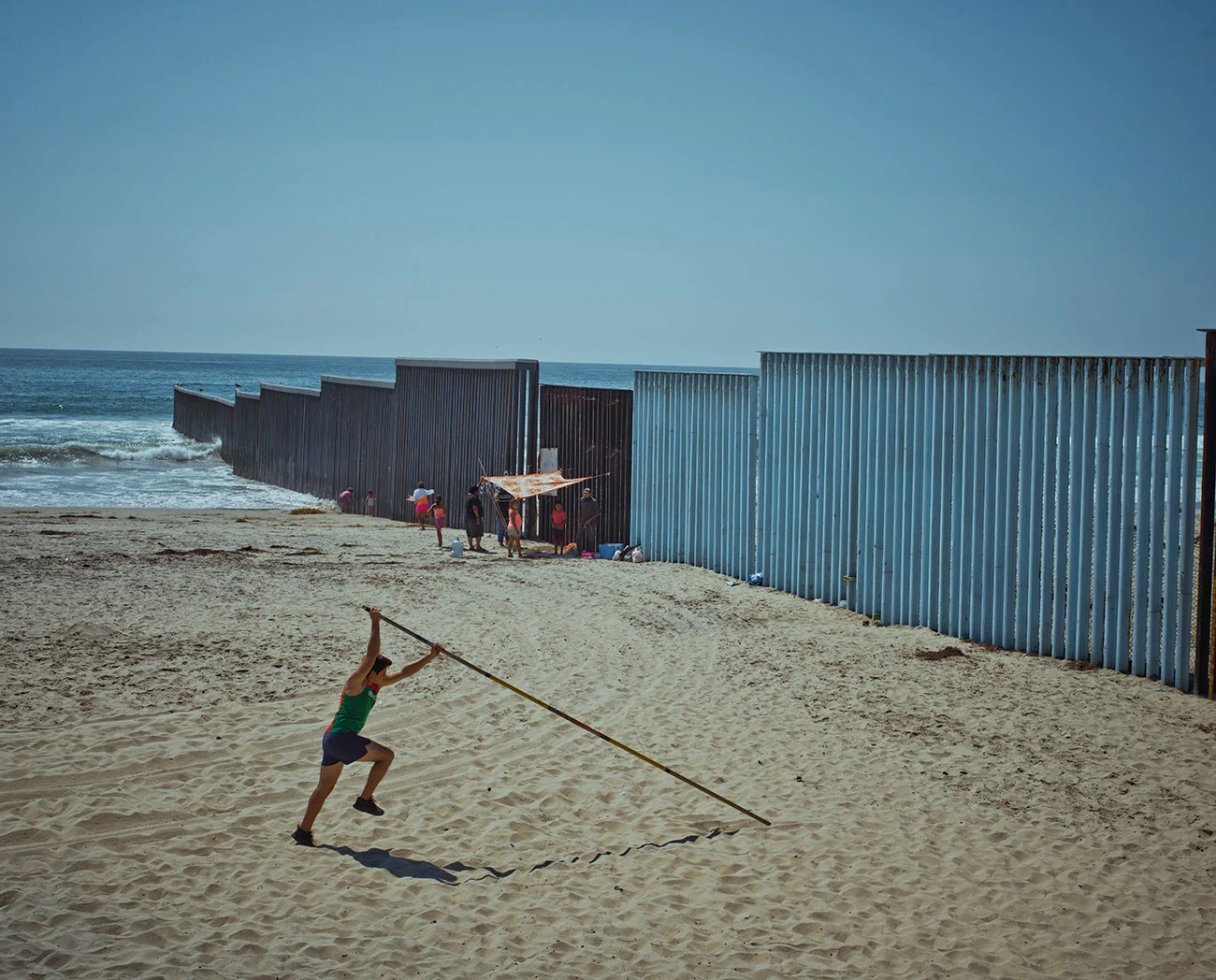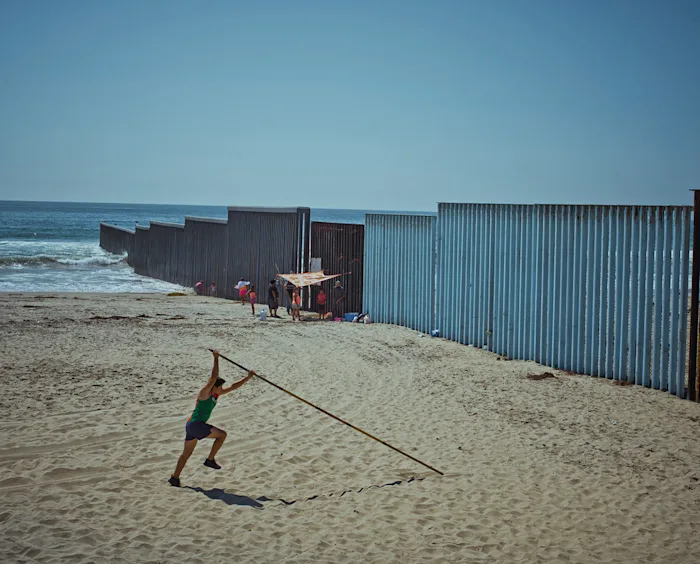Monstertutional Conarchy
Daniel Grave
What is “new” in the strategy of the second Trump administration? In a two-part essay composed last month, Daniel Grave sketches the key elements of the techno-feudalist wager currently underway. According to Grave, the rapid-fire institutional shake up we’re seeing must be interpreted, ultimately, as the “counter-revolution that we have earned”: reactive measures aimed to reverse fifteen years of liberatory ruptures.
Other languages: Français
I. Monstertutional Conarchy
Across the country, people are feeling confused and overwhelmed by what Trump, Musk, and others have been doing since the inauguration. This confusion is also usually accompanied by the sense that it is exactly the point. I’ve heard over and over that “They want us confused.” That confusion is part of some bigger strategy.
I agree. Its sometimes called “the Shock Doctrine,” a tactic that has been used with great success by corporations and governments for many decades. The idea is that the creation of a sense of shock in a population can paralyze them, and allow for policies and plans to be pushed forward that no one would otherwise accept or agree to.
But recognizing that we are experiencing shock as a part of a wider strategy isn’t really enough. We have to ask what that strategy is. What goals might this shock and confusion be trying to further?
I’m going to present a theory that seems to click a lot of things into place. This is a theory that others have articulated, though I want to spell out the consequences of it in order to orient us toward responses that are adequate to the challenge.
I need to admit up front that this is, technically, a conspiracy theory. I am saying the best way to account for what is happening is to attribute a number of apparently disconnected events to the not-so-secret plans of a few powerful people. These kinds of conspiracies are normal fare in the real world.
Not all conspiracy theories are paranoid delusions that attempt to connect all events to the secret machinations of a few all powerful people. This theory does not explain everything, nor do I think those who it describes are all powerful. They make plans that turn into action, and like all plans, things go wrong along the way. They don't always get what they want. Unexpected forces sometimes arise to slow or stop them entirely, which include the obstacles that may be posed by everyday people who have decided to engage in conspiracies of their own.
This theory is worth considering, because if it is even partly correct, it has some serious consequences for what it will mean to respond to this moment for anyone who cares about political freedom, the fate of the earth, and a lot of other things you probably care a lot about. I’ll try to make those consequences as clear as I can along the way.
The “Butterfly Revolution” and the paradox of sovereignty
Remember January 6th?
Remember that there was a riot at the U.S. Capitol that appeared to be timed to interrupt the vote-counting process to certify the election? Suppose, for a moment, that that wasn’t just a random coincidence, but rather a genuine attempt to interrupt the peaceful transfer of power. As we know, it didn’t work. If it was an attempted coup, it was a particularly sloppy one, relying on a lot of domino rows all converging at the right time.
But things could have gone just a little differently. It appears, according to the January 6th commission, that Trump actually wanted to be at the front of the march. He ordered his driver to bring him there, his driver refused, and Trump grabbed the steering wheel and attacked him.So imagine that this driver had caved, and the mass of MAGA supporters had the President of the United States at the helm. It seems likely that the police line would have parted for the President, and he would have walked into Congress demanding the vote count be stopped, followed by a thousand supporters ready to do some very violent things at his command.
If a few things had gone differently, we would have been thrust into very strange territory. Not just because there might have been bloodshed, but even more, because its not really clear that such bloodshed or the interruption of the transfer of power would have really been illegal.
This is because Trump, as the President who had been insisting for months that the presidency was being stolen, could have initiated a “state of emergency.” Had he taken the opportunity to do so, we would have entered a murky and paradoxical zone of the law, in which the law is legally suspended in order to protect the legal order itself.
If that seems confusing — that’s because it is. It is called the “paradox of sovereignty,” and it is the logical circle that forms a big wide hole at the center of every constitution, no matter how democratic: all constitutions have to make it possible to legally suspend the law in order to preserve the legal order. Exploiting this hole has been the primary strategy of fascist movements.


As people know, Hitler was democratically elected. Shortly after his election, he declared a state of emergency, which suspended the Weimar Constitution and transformed the law into his will. Whatever moral crimes the Nazi regime committed, they were not, technically, illegal.
But this wasn’t just Hitler’s plan. Carl Schmitt, the architect of the Nazi legal regime — who J.D. Vance likes to reference — argued that because of this paradox of sovereignty, all democratic parliaments and congresses and courts were basically just debate clubs. When push came to shove, lurking behind every constitution, there was a dictator — a King — whose will was law. The fascist strategy to destroy democratic constitutions was to push things to such a crisis that this principle of dictatorship was able to emerge into the open.
If there were some people rooting for this outcome on January 6, they didn’t get their wish. When the day came, the dominoes got stuck or weren’t laid out right, and those people had to give up on that particular plan.
Assuming there were people that wanted this outcome then, there is no reason to think they went away. Rather, it seems reasonable that they went back to the drawing board and made a new plan, one with a little less reliance on an armed mob.
But we don’t even need to assume it to be the same people. Its also possible that a different group of people who had perhaps laughed off the first Trump administration, saw in the Capitol insurrection a potential that pointed toward their wildest dreams of dictatorship being realized.
Whichever option you pick, the upshot is the same: the creation of a better-thought out plan to assert the principle of dictatorial power. I am suggesting that this plan was made and that it is the best available explanation of the confusion we are experiencing.
The smoking gun of this plan was published in 2022 on the substack of Curtis Yarvin, a neofascist philosopher who has been hard at work playing guru to Silicon Valley billionaires for over a decade. He is a close friend of Peter Thiel, founder of PayPal, who, like him, has also come to believe that democracy should end and some form of Neo-monarchy is the future. Thiel, in turn, is the mentor of J.D. Vance — and donated $15 million to his Senate campaign (more than any Senate donation in history). Thiel is also one of the many billionaires supporting politicians who pushed for Project 2025. Thiel and Musk are two of the figures in the so-called “PayPal Mafia.” There are other people in play, but this nexus of relationships is at the core of the conspiracy theory I am presenting.
So what did Yarvin write? Yarvin called his plan “the Butterfly Revolution,” and outlines a strategy for building a regime-in-exile (the caterpillar) into a beautiful Butterfly — a Monarch butterfly, to be clear. To put it very briefly, Yarvin councils that a plan has to be put into action as soon as the President takes office, when his popularity is the highest:
We’ve got to risk a full power start — a full reboot of the USG. We can only do this by giving absolute sovereignty to a single organization — with roughly the powers that the Allied occupation authorities held in Japan and Germany in the fall of 1945.
The aim is to make the office of the Presidency more powerful, under Trump, than any president beforehand:
Doing this will require powers in the Presidency that have not been seen in the lives of those now living… It will, in fact, require the executive powers of Washington, Lincoln and FDR — or even more.”
The plan requires that Trump himself appoint someone else — “an experienced executive” — to eliminate the bureaucratic and institutional obstacles to this absolute sovereign power:
While in exile, this regime will be a larva — a harmless caterpillar. Once duly elected, in office it will not just caper in front of the cameras (in fact, it will not talk at all to the legacy press) — it will spread its wings, and become a beautiful governing butterfly. Trump himself will not be the brain of this butterfly. He will not be the CEO. He will be the chairman of the board — he will select the CEO (an experienced executive). This process, which obviously has to be televised, will be complete by his inauguration — at which the transition to the next regime will start immediately. [...] The CEO he picks will run the executive branch without any interference from the Congress or courts, probably also taking over state and local governments. Most existing important institutions, public and private, will be shut down and replaced with new and efficient systems. Trump will be monitoring this CEO’s performance, again on TV, and can fire him if need be.
While there is more, this is the essence of what makes Yarvin’s Butterfly Revolution a compelling explanation for the confusing dynamic between Trump and Musk. The aim is a full power start (check), in which an outside CEO is tasked with immediately shutting down or replacing the institutions of government (also check). This also provides us with the beginning of an answer to what goal the confusion we are experiencing is meant to push through: they are removing any obstacles to the expression of an absolute sovereign power — which is the political theory phrase for “King” or “Dictator,” someone whose will and whim is identical to the law. A Presidency so powerful it is effectively indistinguishable from Monarchy.


Now in his original 2022 post, Yarvin did not seem to think Trump could carry out this plan. He says Trump is a “farce,” his “brand is trashed,” he “doesn’t have the strength,” he’s “too old.” But, he says, “I won’t disguise my belief that someone should. Someone worthy of the task, of course.”
Yarvin is a coy writer, full of little winks and dog whistles. It is possible he was just trashing Trump to turn his script for a fascist coup into a safe thought experiment. It is also possible that he and Thiel thought they had found someone “worthy of the task” in Vance.
But it is worth noting that, in a January 29, 2025 post called “The Pleasure of Error,” Yarvin expressed his happy surprise that he was wrong. Its not exactly as he’d hoped — Yarvin had wanted all government employees retired on Day One — but he thinks Trump is doing great at the Butterfly Revolution.
Perhaps this is just grandiosity on his part. But consider the possibility that it isn’t, and that Yarvin’s ideas are at play in a decisive way at the highest levels of political strategy in the Trump administration.
If so, there’s a few things we should understand:
1. This is an American innovation in fascist legal strategy.
For Schmitt, the aim was to declare a state of emergency and suspend the Weimar Constitution. For Yarvin, you don’t actually need to do this: you just need to lean into a different interpretation of the Constitution, what is called the theory of unitary executive power — which Trump has embraced.
This theory has been developed on the right-wing fringe of legal theory for decades, and argues that the Executive Branch is unbound by other branches of government. The bills of congress and judgments of the courts are reduced to recommendations that the President may or may not follow. This theory doesn’t hold any water for responsible historians of the constitution, even conservative “originalists." But it would be a great mistake to assume anyone who promotes this theory cares about the facts.
Perhaps this is the best way to put it: to say that the President is unbound by the decisions of the other branches of government is to say that the U.S. Constitution doesn’t really have those “checks and balances” we were all taught it did. If we had been told this is what made it such a brilliant and important document, one worth pledging allegiance to and defending with our lives, we had been sadly misinformed.
In fact, according to Yarvin, what makes the Constitution so great is that it doesn’t have such checks and balances— that the Executive branch can assume unrestricted power should the country need to be made great again. That is, Yarvin & co. are claiming what everyone else perceives as a constitutional crisis is, in fact, just another interpretation of the constitution. It turns out it is perfectly legal for the elected President to wield monarchical power to remake the government and society — to them, this monarchical power should be called “democracy.”
I’m suggesting that we’re dealing here with a new justification of fascist power, one rooted in a creative interpretation of the Constitution: an American Constitutional Monarchy. Since those who aim to assume this power are perhaps the most effective con artists and moral monsters in our society, we might better call it a monstertutional conarchy. But cute names aren’t likely to help us much at this point.
Because I’m also suggesting that this has, in fact, already been accomplished, for the simple reason that the President has asserted it and that no other branch of government has the means to force its decision on the President. Trump has already declared, through executive order, that all employees of the Executive branch are bound by the executive’s interpretation of the law. Vance has already said that the Executive is not bound by the decisions of the courts. We should let go of the idea that they are bluffing: to say it is illegal is begging the question, because they have said they are the law. They have the power because they say they have the power and there is apparently no counterpower standing in their way.
2. The aim is to remake both American society itself and our perception of reality.
What is this absolute executive authority going to be used to do?
If Yarvin’s thought is being followed, they aim to first destroy what he calls “the Cathedral,” which he defines as “universities + journalism.” He thinks it is these institutions that generate a certain sense of objective truth about reality that lies and bullshit are measured against. It needs to be destroyed in order to make way for the new principle: that Trump himself is the standard of truth. As his press secretary said, “it is a fact that the body of water off the coast of Louisiana is called the Gulf of America, and I’m not sure why news outlets don’t want to call it that, but that is what it is.”
Destroying the cathedral is a top priority in this plan. Journalism must accept the principle, historically associated with kingship, that something is so simply because Trump says it is — that his words themselves can reshape reality. Universities have already suffered intense new restrictions on free speech and funding has been pulled on the grounds of any language suggesting “wokeness” — words like “Black” and “women” and “disparities” and “systemic.” But this is just the beginning. In an interview laying out his vision, Yarvin said: “there should be no universities by April.” Now, I’m not saying they are on schedule and that Yarvin is getting all his wishes. But I am saying we should understand that we are not in a situation where they are simply going to purge the “woke” language and DEI policies and then we’ll settle into a new normal. He wants it to be rapid confusing chaos, so that by the time we catch our breath and understand what’s happening, there is no public standard of truth to measure it against. And I’m saying that just like what we are experiencing now was largely unimaginable even two months ago, we should expect that two months from now will be similarly beyond the pale.


The mechanism for disciplining the universities has also been outlined: replace the head of the Department of Education with a loyalist, fire the accreditation board, rehire loyalists to rewrite the standards to align with Christian Nationalism, and demand all universities comply in order to receive federal funding. If they refuse to comply, fine them for the size of their endowments. This has been stated as an aim publicly.
3. They think this can be done without the consent of the population.
Yarvin says, “all you need is the police.” And, presumably, the military. And, if his writing is to be believed, it will also help to be able to call on armed militias. He thinks that this should be enough to discourage anyone from being tempted to push back in any way that might matter.
The police are the police — they use violence to enforce whatever the law happens to be (or whatever someone above them tells them the law is, because usually they have no actual knowledge of the law). Nothing new to say about them at this point.
The military is undergoing drastic changes that are worth mentioning, because if indeed Trump is overstepping the historical understanding of the Constitution, one possible path — which has precedent in other countries — is a military coup to restore the Constitutional order. The appointment of Hegseth as Secretary of Defense and the purging of top military brass seems to suggest this is a possibility they are trying to head off in advance.
The armed militias are another factor, many of which are deep in the Trump cult. Yarvin proposed creating an app to organize armed Trump supporters that will group them into “cells” with others nearby and send them tasks, allowing them to test the response rate and make predictions about how many would show up when needed. Recently, an app was released called Patrol which organizes former police and veterans into neighborhood patrols, funded by Balagi, who is one of Yarvin’s pals.
4. All this is a means to an end: to remake the world order.
So, before we pause, I want to say one more thing which is even weirder. Because it is so strange, I need to preface it by asking you to imagine describing our lives today to someone alive 30 years ago. Imagine telling them about smartphones and streaming and AI and how everyone spends so much time staring at screens. Consider that we already live within someone’s dystopian nightmare, brought to us by Silicon Valley.
Now just imagine that the future that Yarvin and others have in mind is just carrying this forward: the remaking of the world into corporate-owned city states, in which the price of citizenship is the surrender of all political freedom. These “freedom cities” are under total surveillance, guarded by AI weaponry, and maybe even governed by AI monarchs. I’m not kidding, this is literally what they want, they openly fantasize about AI weapons mowing down anyone who would dare protest in their utopia.
Let me be entirely clear: this is batshit. And just because this is something they want, there are many, many things that can go wrong for them along the way.
And I’m not saying we’re anywhere near this situation. I’m just saying that some of the people who seem to have a big hand in shaping world events, see themselves as doing so in order to clear the way for a whole new system of, what they term, “human dominion.”
A small group of billionaires and their friends have granted themselves permission to dream big. Anyone who is not interested in being herded into their fantasies should, at the very least, have a sense of what those fantasies are.
That’s the bad news. But, there’s some good news too: those waging it see themselves as counter-revolutionaries. They are neo-reactionaries to a movement that they have come to understand as a threat to their power. This may come as a surprise to the rest of us. What revolutionary movement are they reacting to that they think is capable of challenging the power of billionaires and AI monarchists? If we shift our perspective just a little on the last 15 years of social movements, we can see that such a movement has indeed been marching us toward the historical fork in the road that we’ve arrived at. And there is a Left turn we can take.
The Counter-Revolution We Earned
We are now 9 weeks into the second Trump presidency. In that time, nothing has occurred that suggests we are not on the path of the Worst Case Scenario — an overtly fascist movement making moves toward an overtly fascist government. The administration has articulated its right to a Monarchical form of power in line with the strategy of the Butterfly Revolution articulated by Curtis Yarvin. There are, of course, other ideological forces. But this strategy appears to be a decisive one.
As outlined above, the stakes are about as high as can be imagined. Not just because of the “constitutional crisis” we are heading in, but because:
1) The administration is deploying an interpretation of the constitution that will refuse to acknowledge that crisis, arguing instead that the Executive, properly understood, is unbound by the other branches of government;
2) They appear to want to use this new monarchical power to reorganize American life and the world order. Their vision is the stuff of nightmares — the complete erasure of political freedom, the complete enclosure of public institutions into private hands, the use of AI for total surveillance and weaponry to eliminate the sliver of humanity that causes so much inconvenience for policing and “warfighting.” They aim to use a constitutional monarchy to herd us into a monstertutional conarchy. The monster con, if you like.


There’s another aspect of what is unfolding that is difficult to wrap our minds around — particularly for those on the Left who imagine that the goal of right-wing movements is to rake in profits for corporations. Surely the fact that tariffs are bad economic policy will act as a tempering force? Surely they wouldn’t deliberately crash the economy, trigger a recession or even a depression? “Its the economy, stupid!”
Maybe. But note that Musk has said on numerous occasions that the economy needs to be crashed. Note that Trump, who never admits a fault, has himself said that things might be hard for a while. Run that through your euphemism machine. If we are living through a suped-up version of “disaster capitalism,” it could follow, for some particularly cynical billionaires, that the US economy needs to be crashed. They are driven by a fantasy of a “blank slate,” which they want in order to:
lower expectations of workers to get them to accept jobs they otherwise wouldn’t;
justify the gutting of environmental and worker regulations to re-attract industry;
create a situation of economic chaos not unlike the late Weimar period in which the fascist movement can position itself as the only force capable of restoring order.
If that’s too outlandish to imagine, I just want to remind you that two of the most influential figures on the political Right today — Musk and Bannon — have both given Nazi salutes in public. Let it sink: we are in that kind of political situation.
Thankfully, the influence of Yarvin’s ideas has begun to get attention. Unfortunately, attention is not opposition. If the plan, as Yarvin outlined it, is to force these changes through without much concern for public opinion — and to destroy or bring to heel any institution that might raise questions about the King’s interpretation of law or history — then what? In targeting Universities and the media, they are laying the condition for Trump to remake the world with his edicts, backed by physical and economic bullying. It is the Gulf of America. Maybe it always has been.
If this is indeed the path we’re on, the Democrats aren’t in a position to do much of anything about it, even if they wanted to. As a party, they have committed to “taking the high road” in all circumstances — by which I mean, they are committed to always giving the impression that they are the ones following the rules. This was quaint for a while. It is now completely unhinged. They are trying to follow the rules of a game that the other party simply isn’t playing.
Could they get hip to the new game? Not really: Monarchy is zero-sum. When sovereign power is absolute, you either have it or you don’t. The best you can do is win favor with the sovereign. This amounts to becoming junior partners in the regime, a loyal opposition that can’t fundamentally challenge any of the priorities.
At the wheel are people who revel in being beyond the limits, acting in ways so unbound by basic decency that it sounds crazy to even say what they are thinking. This is how they win: by their opponents being unwilling to attribute to them the audacity of evil.
But hold on: isn’t Trump pissing off the Republican base so much that the Democrats have a chance to sweep the Midterms? Shouldn’t we just give them enough rope to hang themselves with? My dear friend. These are not the kind of kids who give the ball back.
Whatever you may have thought about how representative or functional or legitimate the American voting system was in the past, I am asking you to let it sink in that this system is now in the hands of people who have no qualms about tipping the scales.
Perhaps they will find it politically convenient to have elections. Perhaps not. But such elections are not going to change the hands of power. Do you really need to see that yourself to be convinced? Haven’t you seen enough? Haven’t they shown you who they are?
And what do you think the sources of your news will be saying, two years from now? The zone will not simply be flooded with bullshit. A whole new zone will be made out of shit.
All political systems rely upon a set of customs that are not themselves defined within those systems. They are simply the stuff of everyday life, expectations of honesty and good will and sharing and a commitment to dialogue in search of the truth. You could call it “democratic culture,” as some have. The current fascist regime has wagered that these customs have themselves eroded to such a point that the political system they were built upon can be swept away.
Are they right? That’s what we’re here to discuss. And, for those up for a challenge, we have some good news. It will take a bit of explaining, though.
Their wagers
The Christian/Techno fascist alliance is making some very serious wagers, which could put their strategy at risk.
To name a few of the more obvious:
That they can succeed in laying the legal and institutional framework for this transformation while people are in a state of shock, without serious popular opposition;
That if they do receive opposition, they can nonetheless push it through with physical and economic coercion and not widespread consent;
That Americans don’t really care about or even understand the meaning of political freedom. That most people do not want to think about politics and would prefer the country to be run like a business;
That they can rely upon a functioning apparatus of surveillance, economic blackmail, and the loyalty of paramilitaries, police, and military violence to extend their power;
That the divide between Red and Blue worlds can be maintained and intensified, and that people will remain within these easily manipulated media bubbles;
That they can present themselves as the best solution to the chaos they have created.
At first glance, these might sound like pretty safe bets to make. But I want to suggest that it only seems this way.


You know how, in some contexts, things feel one way and you feel one way about yourself, but when you get into a different context somehow you remember all sorts of things you are capable of?
One effect of the kind of confusion being imposed on us from above is this kind of amnesia, the situational forgetting of our own capacities. This is the first thing we need to overcome.
We can do this by understanding that this is a counter-revolution. These billionaires are “reactionaries” — and they conceive themselves as reacting to the power of our social movements.
Remember the summer of 2020? It’s publicly remembered as a ‘largely nonviolent movement for a racial reckoning' that resulted an increased awareness of ongoing structural racism and a new wave of DEI policies. A supercharge of “wokeness” that is now under direct attack. In 2020, it felt like the triumph of a new common sense was being solidified into corporate and institutional policies around the country.
To start, I think we need a fuller perspective on that memory. That movement did not really emerge spontaneously in response to the brutal murder of George Floyd in Minneapolis. Rather, it was the culmination of a series of increasingly powerful movements stretching back at least to Occupy Wall Street in 2011. Whether you participated in them or not, I want to suggest that these movements likely affected your life by catalyzing a series of shifts in popular common sense.
Counter what revolution?
It is easy to look at the last 15 years of uprisings and see nothing but failure, or to blame certain strategic or tactical orientations for preventing the movements from seizing and wielding power. I’d like to offer another perspective.
Maybe the best way to lay it out is to describe how people in the US tended to think about the world in public before 2011 — I say “in public” because there were always smaller groups of radicals who had a different understanding, but they were largely excluded from public discourse.
For most people, “history” was more or less over. Things like racism and patriarchy were problems that were largely struggles of the past, which had more or less been overcome. Capitalism and our democratic system were the best, or at least only viable, way for economic and political life to be organized. Our job was to find a job we liked, so we could realize our personal vision of life within these systems. We were not, on the whole, people with a transformative historical task: the great liberation struggles of history were in the past and we were now free and equal participants in the market. Let’s call this “the ideological fabric of neoliberalism.”
What I want to suggest is that in the wake of the financial crash of 2008, this ideological fabric was shredded by a series of social movements. We can look at each of them as introducing an insight that tore a new hole in it, allowing a new common sense to emerge. The process could be hastily summarized like this:
The Occupy Movement (2011-12) taught us that capitalism is not the only or best way to organize life, and that there is something like a class war from above being waged against the vast majority of people;
The Ferguson Uprising (2014) and subsequent anti-police riots in Baltimore, Charlotte, and elsewhere taught us that anti-Black racism is not over. Rather, it persists in structural forms maintained through racist policing practices that have built a system of mass incarceration;
The Standing Rock Rebellion (2016) taught us that colonization and indigenous genocide is not something that happened in the past and is a tragically complete original sin that no one can do anything about. Rather, colonization is an ongoing process that is still happening today;
The Me Too Movement taught us that patriarchy is not over as a result of formal legal equality and that the contemporary feminist task is far greater than closing the wage-gap. Rather, patriarchy persists in a hidden continent of sexual assault and rape that men engage in with impunity;
The Queer and Trans Liberation movements taught us that the pursuit of an individual sense of happiness in the world requires the courage to liberate oneself from some of the most basic categories of who this society says we are, and discover new ways of being in the world;
The Climate Justice Movement taught us that our economic system is rapidly destroying the conditions for human life on the planet, and that urgent action is required to fundamentally change the conditions of our lives.
Each of these movements forced these insights into the public arena, tearing holes in the fabric of neoliberal ideology. In doing so, they developed a new common sense in which people regained the idea that they were situated in a generation that had an historical task to remake the economic and political structures of the world.


And again and again, in each of these movements, people discovered that once they broke free of neoliberal ideology, there was another force sustaining the world as it is: the police.
Recall again the summer of 2020. As I said, it has been officially remembered as a largely non-violent movement for racial reckoning that transformed corporate ad campaigns and institutional policies. In fact, it was the George Floyd Uprising. It began with the burning of a police station and, for about 3 weeks, this country experienced the largest wave of riots in its history, many of which targeted police cars and infrastructure, paralyzing the police’s ability to maintain order in multiple cities.
These few weeks at the beginning of the summer were not aberrations that can be written out of the history of that movement, nor were they actions that prevented the movement from becoming popular. Rather, they were the initial explosion of energy that dwindled as the movement became progressively more tame, less disruptive, and more guided by official nonprofits and demands for policy changes that could be won within existing institutions.
After 2020, there was a lull in Left social movements. A notable exception to this was the Stop Cop City campaign in Atlanta, which conceived itself as a continuation of that movement to prevent the construction of a new wave of police training facilities that aimed to reconstruct their public image.
But in the spring of 2024, encampments to stop the genocide in Palestine were created by students and activists at universities across the country. This movement too contributed to the process of education I am describing, teaching us that the US is still actively committed to supporting regimes conducting genocide. And that even our most “liberal” institutions are willing to self-destruct to prevent that truth from being uttered.
The intensity of the police response to the Palestinian solidarity movement suggests that a new kind of limit was hit by this movement. The commitment to supporting the state of Israel’s assault on Palestinians seems to run so deep that both political parties and University administrations around the country appeared to agree that it would be better to simply destroy freedom of speech on college campuses and slander people trying to oppose a genocide than to acknowledge the humanity of the Palestinian people.
Suddenly, on top of the insights described above, which were largely focused on unearthing the contours of domestic oppression, there was a direct focus on the implications of state, academic, and corporate institutions in US imperial policy. This meant that the movement’s basic moral insight simply could not be integrated into existing institutions as a new policy or training.
I know this is leaving a lot out. Any nutshell narrative of a decade plus is going to. But if you find this more or less plausible, then consider two points that I think provide some perspective on what it might mean to interrupt the plans currently being imposed upon us:
First, what if we think of this cycle of movements as a process of collective education, a process of our digging beneath the illusions and unearthing the real history of the United States? Each of these movements demanded that we rethink who we are, developing a new framework to make sense of our own lives and actions. They were forces of memory that challenged the amnesia imposed upon us. This process is what might be meant by “progress” in the moral sense, in the sense of deepening popular education and changing common sense in a way that is more grounded in the reality of people’s lived experience and the operations of power.
Second, if we have indeed arrived in a situation in which a dictatorship is emerging, and if that dictatorship relies on the power of the police to enforce its will, then it is worth remembering that we all have some memory of how the police can be obstructed from doing so. In the early Summer of 2020, we caught a glimpse of the ability for everyday people to paralyze the apparatus by which their will is imposed on us.
To summarize: I’m inviting you to understand what is happening today as not simply something that powerful people are doing to us powerless people. Rather, it is a counter-revolution that we have earned. Because our struggles for justice have been so effective at disrupting their political game, the ruling class of billionaires and their neo-fascist gurus have been forced to fundamentally change the rules in order to set us all back. It's like we have been winning the game so far, to the point where we have arrived at the big boss: fascist dictatorship, cultural counter-revolution, and a new apparatus of surveillance and policing. The monster con. That is the only roadblock they have left to stop a transformation of common sense from becoming an actual transformation of reality.
The problem in their model
I want to focus on one major tension that has constantly reemerged within this process I’ve sketched, which I think is the structural source of many of the others. Overcoming this tension will, for many of us, require another shift in perspective. But I think we are at a moment where the only chance to rise to the task means one more level of collective education. Because doing so allows us to see the major weakness within the monster con’s counter-revolution.
To see it, we have to acknowledge that in attacking what they call “wokeness,” they are in practice attacking the policies that have attempted to adapt existing institutions to the moral progress in common sense that I’ve described above: DEI policies, federal funding for health, science and critical thinking, climate justice, etc.


Now this reveals two perspectives that were always in an uncomfortable relation across the process I described. Let’s give them names:
The Institutionalist perspective: From one perspective within the movements, the institutionalization of values is what progress looks like: demands that originate from moral outrage in the streets become codified in workplaces, policy, and law.
The Counter Power perspective: From another perspective within the movements, these institutional forms of progress were always, at best, band-aids that didn’t really solve the problems — and at worst, they were ways of actually stopping the energy of social movements and maintaining the status quo. The change in policy and diversity in “seats at the table” were a way of preventing genuine transformation from happening. In words I vividly recall from a clergy member speaking in St. Louis after having been tear-gassed in Ferguson, “we have been demanding inclusion into power, but the point should have been to dismantle the institutions of power itself.” The Counter Power perspective held that organizational forms to sustain moral progress — and the conditions of life itself — had to be built up at a distance from and in opposition to state-controlled institutions.
This tension has long existed within movements for social justice. Those working with existing institutions say the radicals in the streets aren’t being realistic — to be “realistic” means to adapt lofty demands to existing powerful institutions and set progressively better standards within them.
But those in the streets always had a compelling response. They would say that it is this piecemeal progress that is, in fact, unrealistic: if you rely on state-supported institutions for moral progress, then it can all be erased the moment the winds of state power shift and blow in a different direction. Moreover, if you’ve built up the power of those institutions in the process — giving them more legislation, more police, more surveillance — then these institutions will be in a position to do even greater damage when the winds shift, as they inevitably will when the power of the ruling class is genuinely threatened.
Maybe things could have gone another way. Maybe progress within institutions could have been continually pursued without this backlash. But I think we have to admit that it hasn’t worked out that way for us. For better or worse, the street side of the argument has won, and we have to admit that progress can’t be trusted in the hands of institutions that are subject to state authority: it must be built and defended outside those institutions. I hope to elaborate on this theme in future posts.
So, at long last, we can get to the weak point in the ongoing Butterfly Revolution. Its this: if the street side is right, then the institutional forms progress has taken are not actually the threat those in power think they are. Rather, those policies of institutionalized wokeness are, in fact, the means by which the demands for change in the streets have been diverted and tamed in order to maintain the overall power structure. In attacking the institutionalized forms of moral progress, the techno and christian fascists are throwing out one of their own most powerful weapons for suppressing social movements. In directing their attacks at these institutions, they are in fact attacking their own shield.
Those institutional forms of managing demands from below were developed over decades, and for good reason. Should we recognize that our freedom — and everything else — is at stake, and should we choose freedom, they simply cannot hold their project together with violence and bullying alone.
But this will take a massive expression of disruption from below. We’ve seen what that looks like: something like the early weeks of the George Floyd rebellion, but without any illusions of piecemeal demands.
The challenge
In conclusion: a small group of billionaires, scared that the American people were moving in a direction that might actually challenge their power, have granted themselves permission to dream very big about the kind of world they want. They freed themselves from the boundaries of the American Constitution in order to set a course for a new organization of the political world. They have given themselves the right to act boldly to impose this new order on us, and they are not going to stop unless we find a way to stop them.
The question I think we are presented with is this: will the process of education won by social movements be able to take the next step together? Can we drop the illusion that moral progress, the fight for historical justice, and the fight for the future of life on the planet, can be achieved through policies of existing institutions, and give ourselves the right to directly build the future we deserve? Can we drop the bullshit and oppose the apparatus of rule like our lives and the lives of those we love are at stake?Because they are.
One way or another, we are inside a process of fundamentally changing the world. If we don’t want their plan to be the only one on offer, we have to similarly give ourselves the right to dream big, to act boldly, and make clear that it's our vision against theirs.
March 19, 2025
Images: Cristina De Middel